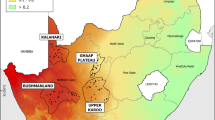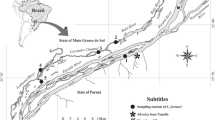Abstract
Levee breaks from the Great Flood of 1993 opened up hundreds of new scour basins in the floodplain of the Missouri River. Subsequent floods, with sediment erosion and deposition, cause these lakes to be temporary features of the landscape. Within two years of the 1993 flood, the majority of zooplankton species from the region had colonized these sites. A positive correlation between species richness and connectivity indicates that sites having higher exchange with the river tended to have more species present, a result which is consistent with higher colonization rates to these sites. Hatching experiments from the sediments revealed that remnant oxbows have a highly diverse egg bank, whereas the young scour sites have limited species and numbers present. The depauperate egg bank implies that long-term population dynamics of the scours may be more dependent upon repeated colonizations than are lakes with regular emergence from the egg bank.
Similar content being viewed by others
References
Boileau MG, Hebert PDN and Schwartz SS (1992) Non-equilibrium gene frequency divergence: persistent founder effects in natural populations. J Evol Biol 5: 25–39
Brooks JL (1959) Cladocera. In: Edmondson WT (ed.), Freshwater Biology. Wiley, New York, pp. 587–656
Delorme LD (1991) Ostracoda. In: Thorp JH and Covich AP (eds.), Ecology and classification of North American Freshwater Invertebrates. Academic Press, New York, pp. 691–722
Dodson SI (1992) Predicting crustacean zooplankton species richness. Limnol Oceanogr 37: 848–856
Dodson SI and Frey DG (1991) Cladocera and other branchiopoda. In: Thorp JH and Covich AP (eds.), Ecology and Classification of North American Freshwater Invertebrates. Academic Press, New York, pp. 723–786
Eisenbacher EM, Black AA and Havel JE (1996) Zooplankton diversity in post-flood scours of the Missouri River floodplain. Annual meeting, American Society of Limnology and Oceanography, Milwaukee, Wisconsin
Galat DL, Kubisiak JF, Hooker JB and Sowa LW (1997) Geomorphology, distribution, and connectivity of lower Missouri River floodplain waterbodies scoured by the flood of 1993. Verh Internat Verein Limnol 26(2): 869–878
Galat DL, Frederickson LH, Humberg DD, Bataille KJ, Bodie JR, Dohrenwend J, Gelwicks GT, Havel JE, Helmers DL, Hooker JB, Jones JR, Knowlton M, Kubisiak J, Mazourek JC, McColpin A, Semlitsch RD and Renken RB (1998) Natural and controlled flooding of channelized Missouri River wetlands: complementary processes for restoring river-floodplain connectivity. BioScience 48: 721–734
Hairston NG, Jr and Caceres CA (1996) Distribution of crustacean diapause: micro-and macroevolutionary pattern and process. Hydrobiologia 320: 27–44
Hairston NG, Jr, Van Brunt RA, Kearns CM and Engstrom DR (1995) Age and survivorship of diapausing eggs in a sediment egg bank. Ecology 76: 1706–1711
Haney JF and Hall DJ (1975) Sugar-coated Daphnia: A preservation technique for Cladocera. Limnol Oceanogr 18: 331–333
Havel JE and Hebert PDN (1993) Daphnia lumholtzi from North America: another exotic zooplankter. Limnol Oceanogr 38: 1837–1841
Hebert PDN and Crease TJ (1980) Clonal coexistence in Daphnia pulex: another planktonic paradox. Science 207: 1363–1365
Hebert PDN and Finston TL (1993) A taxonomic reevaluation of North American Daphnia (Crustacea: Cladocera). I. The D. similis complex. Can J Zool 71: 908–925
Horne AJ and Goldman CR (1994) Limnology, 2nd edition. McGraw-Hill, New York
Hynes HBN (1970) The ecology of running waters. University of Toronto Press, Toronto, Ontario
Jenkins DG and Buikema AL Jr (1998) Do similar communities develop in similar sites? A test with zooplankton structure and function. Ecol Monogr 68: 421–433
Jennings DK (1979) An evaluation of aquatic habitat associated with notched dikes on the Missouri River, Missouri. Master's Thesis, University of Missouri, Columbia, Missouri
Junk WJ, Bayley PB and Sparks RE (1989) The flood pulse concept in river-floodplain systems. Can J Fish Aquat Sci Spec Publ 106: 110–127
Knowlton MF and Jones JR (1997) Trophic status of Missouri River floodplain lakes in relation to basin type and connectivity. Wetlands 17: 468–475
Koellner WH (1996) The flood's hydrology. In: Changnon SA (ed.), The Great Flood of 1993: Causes Impacts and Responses. Westview Press, Boulder, Colorado
Kubisiak J (1997) Lower Missouri River flood-scoured basins as fish nursery: The influence of connectivity. Master's Thesis, University of Missouri, Columbia, Missouri
Mazourek JC (1998) Dynamics of seed banks and vegetation communities in existing and potential emergent marshes in the Missouri River floodplain. Master's Thesis, University of Missouri, Columbia, Missouri 73
Meffe GK and Carroll CR (1994) Principles of conservation biology. Sinauer Associates, Sunderland, Massachusetts
Mitsch WJ and Gosselink JG (1993) Wetlands, 2nd edition. Van Nostrand Reinhold, New York
Pace ML, Findlay SEG and Lints D (1992) Zooplankton in advective environments: The Hudson River community and a comparative analysis. Can J Fish Aquat Sci 49: 1060–1069
Pollock ML, Naiman RJ and Hanley TA (1998) Plant species richness in riparian wetlands-A test of biodiversity theory. Ecology 79: 94–105
Prepas E (1978) Sugar-frosted Daphnia: an improved fixation technique for Cladocera. Limnol Oceanogr 23: 557–559
Proctor VW (1964) Viability of crustacean eggs recovered from ducks. Ecology 45: 656–658
Proctor VW and Malone CR (1965) Further evidence of the passive dispersal of small aquatic organisms via the intestinal tract of birds. Ecology 46: 728–729
Reice SR (1994) Nonequilibrium determinants of biological community structure. Amer Sci 82: 424–435
Repsys AJ and Rogers GD (1982) Zooplankton studies in the channelized Missouri River. In: Hesse LW, Hergenrader GL, Lewis HS, Reetz SD and Schlesinger AB (eds.), The Middle Missouri River. Missouri River Study Group, Norfolk, Nebraska, pp. 125–146
Saunders JF and Lewis WM (1989) Zooplankton abundance in the lower Orinoco River, Venezuela. Limnol Oceanogr 34: 397–409
Schwartz SS and Hebert PDN (1987) Methods for the activation of the resting eggs of Daphnia. Freshwat Biol 17: 373–379
Shiel RJ (1985) Zooplankton of the Darling River system, Australia. Verh Internat Verein Limnol 22: 2136–2140
Soeken LA (1998) The effect of turbidity on the distribution and life history of river zooplankton. Master's Thesis, Southwest Missouri State University, Springfield, Missouri
Stemberger RS, Herlihy AT, Kugler DL and Paulsen SG (1996) Climatic forcing on zooplankton richness in lakes of northeastern United States. Limnol Oceanogr41: 1093–1101
Thorp JH and Covich AP (eds.) (1991) Ecology and Classification of North American Freshwater Invertebrates. Academic Press, New York
Thorp JH, Black AR and Haag KH (1994) Zooplankton assemblages in the Ohio River: seasonal, tributary, and navigation dam effects. Can J Fish Aquat Sci 51: 1634–1643
Tressler WL (1959) Ostracoda. In: Edmondson WT (ed.), Freshwater Biology. Wiley, New York, pp. 657–734
Van den Brink FWB, Van Katwijk MM and Van der Velde (1994) Impact of hydrology on phyto-and zooplankton community composition in floodplain lakes along the Lower Rhine and Muese. J Plank Res 16: 351–373
Williams LG (1966) Dominant planktonic rotifers of major waterways of the United States. Limnol Oceanogr 11: 83–91
Williamson CE (1991) Copepoda. In: Thorp JH and Covich AP (eds.), Ecology and Classification of North American Freshwater Invertebrates. Academic Press, New York, pp. 787–822
Wilson MS (1959) Calanoida. In: EdmondsonWT (ed.), Freshwater Biology. Wiley, New York, pp. 738–795
Wilson MS and Yeatman HC (1959) Harpacticoida. In: Edmondson WT (ed.), Freshwater Biology. Wiley, New York, pp. 815–861
Yeatman HC (1959) Cyclopoida. In: Edmondson WT (ed.), Freshwater Biology. Wiley, New York, pp. 796–814
Author information
Authors and Affiliations
Rights and permissions
About this article
Cite this article
Havel, J.E., Eisenbacher, E.M. & Black, A.A. Diversity of crustacean zooplankton in riparian wetlands: colonization and egg banks. Aquatic Ecology 34, 63–76 (2000). https://doi.org/10.1023/A:1009918703131
Issue Date:
DOI: https://doi.org/10.1023/A:1009918703131




